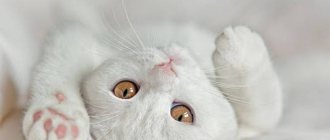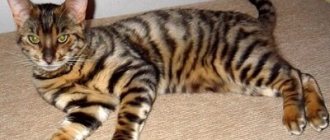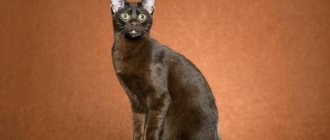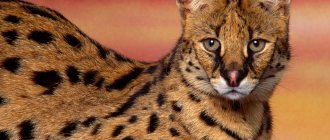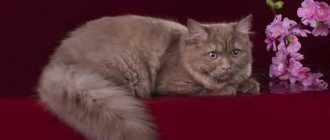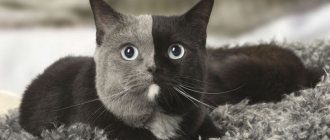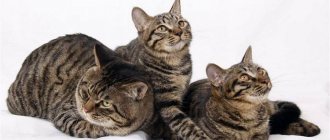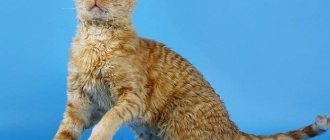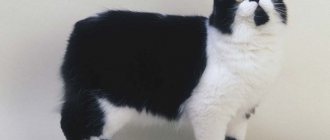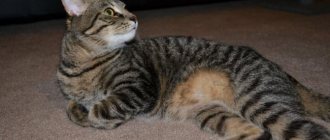Do British Fold cats have fold ears?
It is useless to look for a British fold cat on the lists of international felinological clubs: officially such a breed does not exist. Representatives of the British breed are divided only into short-haired and long-haired, but both have straight ears.
The “British” and their relatives the “Scots” came to Russia in the 1990s. To expand the population, breeders began crossing representatives of both varieties.
The result was the appearance of British Fold cats. From their British parents they received short, dense hair on a stocky body, and from their Scottish parents they received curved ears.
The breed began to enjoy popularity, but in 2004 the international felinological community banned the crossing of “British” and “Scots”. The reason is the frequent manifestation of genetic abnormalities in the offspring: pathologies of the joints and too hard coat.
So the lop-eared “British” remained an unrecognized breed and do not have breed standards. Some breeders generally classify them as “rejected” Scottish cats. Therefore, on the lists of international cat breeding clubs you can only find straight-eared “British” cats.
Difference between the British and the Scots
Some ignorant people call Scottish fold cats “British”, but this is wrong. “Scots” are a separate breed, representatives of which are both straight-eared and fold-eared.
It is not difficult to distinguish between “British” and “Scots”. The characteristic appearance features of both breeds are shown in the table.
| British | Scotsman | |
| torso | stocky, well-muscled, rather large | slender, harmoniously built, medium size |
| limbs | strong, large, round paws | graceful, proportional to the body |
| tail | short, thick, with a rounded tip | quite long, wider at the base than at the end |
| head | large, round, high cheekbones, thick cheeks, short neck | small, with a pronounced chin, prominent neck |
| ears | only straight, ends slightly rounded | can be straight (Scottish Straight) or saggy (Scottish Fold) |
| wool | medium length, voluminous, with thick undercoat | soft, less dense than its British relatives |
Health, reproduction, kittens
British Folds were created through crossbreeding, so they can be quite sickly.
In particular, they have a high risk of developing the following pathologies:
- Deformation of cartilage in some individuals affects not only the shape of the ears, but also the entire spine. Therefore, they may experience fusion of the vertebrae, shortening of bones and thickening of joints, and the appearance of bone growths, which can only be corrected surgically.
- Hypertrophic cardiomyopathy (HCM) is a genetically determined uneven thickening of the interventricular septum and ventricular walls. Progresses to heart failure with chest pain. The disease makes itself felt in individuals after a year and is detected by ultrasound.
- Obesity. Due to a good appetite, if you do not monitor your pet’s nutrition and activity, it can gain excess weight quite quickly. This in turn will lead to many health problems. A proper diet, outdoor games and plenty of space in the house or yard increases his activity and reduces the risk of illness.
- Worms, fleas and other parasites come from the outside, are absorbed with food or hairballs when licking, especially if the cat is in contact with other animals. Now there are many means to get rid of them, which are best used as prescribed by a veterinarian.
- Infectious diseases. These are immunodeficiency, aspergillosis with chronic runny nose, calcivirosis and rhinotracheitis. And especially life-threatening peritonitis, panleukopenia, leukemia, rabies, tuberculosis. To prevent them, vaccinations are necessary: annual against rabies starting from the age of 8 months, and others no later than the three-year period when maternal immunity is still in effect.
On average, adults live from 14 to 20 years if you monitor their condition.
For example, periodically lifting an animal by its front legs reduces the likelihood of developing spinal pathologies. Timely and proper care will avoid many other problems.
Particular attention should be paid to the issue of breeding pets. If owners want to get healthy offspring, under no circumstances should individuals with the same gene be crossed when both of them have drooping ears.
It is worth taking individuals with straight and curved ears, it is better if both of them belong to the British breed. And after 9 weeks it will be possible to get a mixed litter, but the likelihood of their mutation is significantly reduced.
The peculiarity of lop-eared cats is that they are all born with erect ears. They acquire their shape only on the 21st day, then it will be clear which of the babies will be straight-eared and which will be a typical representative of the British breed.
The owners will only have to choose suitable nicknames, remembering that the British are proud and independent animals, and they will serve their family faithfully.
Description of the breed
The English ancestor gave the “British” a proportionate, strong body with developed muscles, and the Scottish ancestor gave him an amazing variety of colors.
Although there are no breed standards, breeders identify a British Fold cat by the following external characteristics:
- the head is round, cheeky and high cheekbones, the chin is pronounced;
- the nose is short, smooth, slightly flattened;
- the neck is thick, inconspicuous;
- the eyes are large, round, the color of the iris is determined by the color;
- ears are medium in size, straight or curved, the base is wide, the tip is slightly rounded;
- the chest is voluminous and wide;
- the limbs are strong and short, the paws are rounded, the toes are neatly positioned;
- the tail is short, mobile, the tip is slightly narrowed, rounded;
- The coat is dense and pleasant to the touch, the undercoat is voluminous, the hairs are longer and shorter.
ATTENTION! British kittens are not born with droopy ears. Folding ears begin to appear on the 20th day from birth.
How to choose a kitten
Kittens are born with protruding ears. The tips of the ears droop at three weeks of age. Therefore, it is not recommended to purchase a kitten younger than 30-45 days.
The choice of a kitten consists of an external examination and verification of documents, of which a veterinary passport must be present, as well as information about the parents.
For your information! Pedigrees marked with international classifications cannot be authentic, since the breed does not have an official status.
Fold kittens can be "British" or "Scottish". It can be difficult to determine which kitten is presented and identify external differences in babies, but this can be done with careful examination.
Fold-eared “British” kittens are denser and stockier with a wide straight nose and a long, thick tail ending in a rounded tip.
“British” kittens with cute floppy ears are hard to distinguish from “Scots”
During an external inspection, the buyer should check the cleanliness of the eyes, ears, uniformity and quality of the coat.
Colors
The coat of a British cat can be either monochromatic or multi-colored, including 2 or 3 colors.
Plain “British” ones are:
- blue (classic version);
- silver-gray;
- white;
- black;
- brown;
- red;
- peach.
Multi-colored cats are:
- tabby (striped color);
- bicolor (a combination of dark and light colors);
- smoky (each hair is transversely divided into two shades);
- "Siamese";
- "tortoiseshells".
Proper nutrition
Many owners do not fully understand what kind of nutrition is important to provide to British cats. Experts recommend feeding them only natural foods, as well as special food.
The importance of proper food for British cat breeds
Do not forget that this breed requires a timely supply of vitamins and microelements to the body. You should adhere to the following rules when feeding fold-eared cats:
- When a pet eats dry food, it does not need additional nutrition. Special food for domestic cats already includes a complex of important elements.
- In the case where the owner provides the British breed exclusively with natural products, it is worth adjusting the diet. Experts advise adding lean meats. You can use beef tenderloin raw. It is also recommended to include cleaned chicken and fish in your diet. Don't forget to separate them from the skin and bones first. Boiled eggs are a great addition to the diet of British cats.
- It is allowed to add low-fat cottage cheese and low-fat kefir to the diet of fold-eared cats. It is enough to feed your pet dairy products once every 14 days. Otherwise, liver problems may occur.
- You can also add fresh vegetables to the menu. Cabbage and cucumbers are perfect. Fresh carrots and squash would be a great addition.
- A variety of cereals are considered an essential food. The most useful varieties for this breed are millet and white rice. The basis for their preparation can be meat or dairy. Before serving, you can add finely chopped meat to their composition.
British cats need a proper feeding regimen. It is enough to provide them with adequate nutrition 2 to 3 times a day. Please note that cat food should be supplied in small portions.
Don't forget to give your cat drinking water. It is extremely necessary to change it on time.
Character and habits
British fold-eared pets are calm, non-conflicting, non-aggressive, and phlegmatic. They release their claws only when there is obvious danger, but in most cases they prefer to leave and hide. The “British” remains loyal to his owner only if he takes good care of him.
Positive character traits of the British favorite:
- calm;
- unobtrusiveness;
- curiosity;
- tenderness.
The “British” loves affection, but, like a true aristocrat, does not tolerate being squeezed. He tolerates loneliness without problems and does not require the constant presence of his owner. Also, the British cat is extremely picky about the quality and cleanliness of the tray and resting place.
INTERESTING! British cats are afraid of heights, which is not typical for representatives of other breeds.
Negative characteristics:
- inactivity, lethargy;
- voracity;
- detachment, poor communication.
History of the British and Scots
The dynasty of fold-eared beauties dates back to the 60s of the 20th century. Scotland is considered the homeland of pets with folded ears. The ancestor of unusual babies is called the cat Susie, whose litter included both lop-eared and straight-eared pets.
Representatives of British cats were brought to England by Roman soldiers. The dexterity and skills of the mousecatchers attracted the attention of the residents. Breeders were interested in the appearance of the plush cat, and at a specialized exhibition in 1871 in the capital of the country, a decision was made to breed British cats as an independent breed.
Relationships with other household members and animals
The British Fold will become a loyal friend and companion for the rest of his cat's life. The cat loves his owner immensely and waits for him to return from work. At the same time, it is unobtrusive and does not require constant attention from a person.
Thanks to his high intelligence, the “British” has a good sense of his master’s mood and knows how to adapt to it. He is not afraid of large crowds of people, noise and din, and shows moderate interest in guests. He is friendly towards other family members and sometimes caresses him.
YOU SHOULD KNOW! The "British" cannot stand human crying. If the owner is whiny and often mopes, then the cat will develop a nervous and aggressive character.
A British Fold cat is an ideal option for a large, calm family. The pet gets along well with children and other pets, even non-aggressive dogs. But he can release his claws if a child mocks him.
Difference in character
Typically, British pets are purchased by working people who spend a long time outside the home. Plush pets can be alone in the apartment without fear of loneliness. Importance, aristocratic behavior and sedateness - these qualities distinguish the British from other breeds.
Animals do not like to be picked up or squeezed. The cat itself will approach the owner for a portion of affection. The British are prone to depression, cats need to be interested in active games. Representatives of this breed quickly gain weight; it is important to prevent British pets from becoming obese, especially after castration or sterilization. Extra pounds are an additional burden on the internal organs of pets.
The Scots are easier to communicate with people and other animals. Playful, playful cats resemble dogs in their habits: they can fetch an object thrown by the owner, hide, and frolic with other kids. Scottish dogs are more amenable to education and training. They quickly acquire hygiene skills.
Representatives of the breeds are very clean animals; they will refuse a dirty tray and will not eat from dirty dishes. If they feel unwell, their behavior will attract the attention of family members to their problems. Scottish and British cat in the photo.
Features of care
The breed is capricious; the British Fold requires careful care and high-quality nutrition. Therefore, the potential owner should consider whether he is ready to devote a lot of time and effort to the kitten.
Diet
Representatives of the fold-eared breed are gluttonous, so the owner needs to carefully monitor the diet and control the size of portions so that the pet does not become obese. The cat is fed 3-4 times a day, but the size of one portion should not exceed 200 g.
You can feed the “British” with the best quality ready-made food or natural food.
If the second option is chosen, then the diet includes:
- lean boiled meat and poultry;
- boiled fish without bones;
- boiled chicken or quail eggs;
- boiled vegetables (zucchini, carrots);
- fresh herbs (cucumber, parsley);
- cereal porridges (rice, millet, oatmeal);
- fermented milk products (kefir, cottage cheese).
You should not include salted foods, smoked foods, confectionery and bread products, milk and fatty sour cream, alcoholic beverages, spicy and seasoned foods in your diet.
Hygiene procedures
Clean the cat's ears every 2 weeks. Due to lop ears, dirt and wax quickly accumulate in your pet's ears. For cleaning, use a cotton swab soaked in veterinary ear cleaner.
Every morning the British man's eyes are checked. Accumulations in the tear ducts are removed with a cotton swab moistened with warm water.
Nails are trimmed with a nail clipper once every 3 weeks. Leave no more than 3 mm from the edge so as not to touch the blood capillaries.
They bathe the “British” at most once every six months, using zoo shampoo. And then only if necessary, if the animal is dirty or infected with fleas. Frequent bathing spoils the appearance and structure of the coat. The water is heated to 40 °C.
Castration and sterilization
Representatives of the British Fold cat breed reach sexual maturity at 9 months. If the owner does not plan to breed kittens, then the pet must be castrated or sterilized.
The operation can be performed on a 3-month-old kitten, but stronger and more mature 7–8-month-old kittens are more often castrated. Before the procedure, the animal is examined by a veterinarian and given anthelmintic treatment.
IMPORTANT! In most cases, fold-eared kittens are sold already castrated, since felinological societies prohibit the breeding of an unrecognized breed.
Grooming
The British cat's luxurious, dense coat should be brushed regularly. If this is not done, then the animal will, while licking itself, swallow balls of hair that disrupt the functioning of the digestive tract.
The long-haired "British" is scratched 2 times a week, especially carefully walking the comb over the stomach, back of the head and hind legs. A short-haired cat can be brushed once a week.
Interesting features in the behavior of British cats
The British Fold cat has individual behavioral characteristics:
- May often assume a columnar posture. In other words, she will sit on her hind legs and reach forward as much as possible. (Remember Puss in Boots from Shrek?)
- The fold-eared breed loves to play with children. He enjoys making contact with older people. If the owner has other animals in the house, then this will not be a serious problem for them. This even applies to dogs; their presence will not frighten cats. While living together, they will quickly become friends and can even live in the same room.
- Do not forget that most British cats have a great fear of heights. Experts say that fear appears due to their vestibular system. Accordingly, the pet owner should not worry about the pet moving around cabinets, tables, and other tall objects in the house.
Health and vaccination
Fold-eared “Britons” are at risk for genetic pathologies. This is due to the fact that they are descendants of two closely related breeds, one of which carries the gene for lop ears. This gene not only makes the ears original, but can also cause serious pathologies of the skeleton and bone tissue.
IMPORTANT! In kittens born from two lop-eared individuals, osteochondrodysplasia is inevitable - an incurable deformation of the joints. Therefore, fold-eared pets are crossed only with straight-eared ones.
Fold-eared “British” dogs are also susceptible to:
- hearing loss;
- respiratory viral infections;
- claw fungus;
- helminthiasis;
- flea infestation;
- disruption of the heart;
- the appearance of renal cysts.
For preventive maintenance, your pet needs to be shown to a veterinarian annually and vaccinated. Each vaccine is administered according to the time limits established by the veterinarian. Vaccination helps protect your pet from panleukopenia, rabies, and respiratory infections.
A healthy and well-groomed British Fold cat lives about 15 years.
British/Scottish mix
Initially, breeders bred British and Scottish representatives of the breed. But over time, breeders noticed: such a union produces weak babies with genetic diseases of the spine and joints.
Currently, cross-breeding between Britons and Scots is prohibited. A conscientious owner will not allow the appearance of sick offspring. To get healthy kittens, Scottish Straights are bred with Scottish Folds. The best result is considered to be mating provided that partners of the same color and from the same felinological club are selected.
You also cannot cross fold-eared cats with a fold-eared cat. The presence of the lop ear gene will lead to diseases in the born kittens.
Crossbreed with mestizo
Mating with a mixed breed spoils the breed's advantages; such pets are not exhibited at shows and felinological organizations do not breed them.
Price
There are many nurseries selling British fold kittens in Russia; finding a pet is not a problem. The breeder must provide the buyer with a veterinary passport and information about the kitten’s parents.
If prices for a purebred “Scottish” cat reach 50 thousand rubles, then a British kitten is much cheaper, because this fold-eared cat is an unrecognized breed. For a British fold kitten they ask from 1000 to 5000 rubles.
The lop-eared “British” is loyal, affectionate, playful, and behaves with dignity. Although he cannot participate in exhibitions and competitions, since his breed does not officially exist, he will become a wonderful companion for a lonely elderly person and a friend for a large family.
Did you like the article?
British or Scottish: the choice is yours
People are thinking about buying a specific pet and note important conditions for their choice. They take a cat to a large family with small children or to a busy person who works a lot and loves silence in the house. Or maybe a son or daughter will just like the fat-cheeked baby Briton, and all family members will support the freedom-loving animal.
Whether a playful Scottish pet or a British cat comes to the family: every animal needs care. Information about the external characteristics, character and behavior of animals will help you decide on the choice of your baby.
Nicknames for British fold cats
When choosing names for fluffy British kittens, consider several generally accepted rules:
- Any nickname must contain at least one hissing sound. With its help, a young kitten will easily remember its nickname and will be able to quickly respond to it.
- Try to come up with a name that ends with a vowel sound. It is best if it is the letter “i” or “a”.
- The cat's name should be as short as possible. 1-2 syllables are considered the best option.
For example, a British fold cat can proudly bear the English aristocratic name Henry, Henry, Donald, Alf, Stephen, William or Andrew. You can also choose a cool name for the boy, for example, Ushik or Ushastik. The names from children's cartoons, where the characters had funny ears, such as Mickey, Cheburakha, Elf, Shrek, Dumbo, Goofy sound interesting.
How to name a British and Scottish kitten >> How to name a kitten based on the length of its fur >>
A fold-eared girl can be called Sadness, Ushka or Fold. British cats have good royal and royal names, such as Emma, Matilda, Elizabeth. For girls with blue coat color, the names Dymka, Smokey, Sade or Malvina are perfect.
What can you say about the character of the lop-eared Briton?
Based on the above-described characteristics of the origin of British Folds, one can judge how diverse the characters of kittens that were acquired as British Folds can be. Starting from a small, frightened hooligan and savage to a sedentary, painful whim with poor digestion.
If you are lucky and your baby is healthy and has a typical “British” character, then he will be balanced, calm rather than playful. A sort of little bumpkin who prefers to lie on a pillow and loves to eat delicious food. Of course, even the British can be naughty in childhood, but adult animals, especially neutered cats, need “forced” exercise. Otherwise, they will get catastrophically fat even on a diet. In addition, a sedentary lifestyle, even in a genetically healthy cat, causes unwanted deviations.
If your pet received its character from Scottish ancestors, then it will be more active and have some “cunning”. The Scots are tireless hunters, and they are able to remain motionless for hours while stalking their prey. Just now your cat was lying completely relaxed on the sofa, seemingly not paying the slightest attention to what was happening around him. And now he explodes from his spot and jumps onto the window, because a bird has landed on the windowsill. And you should be prepared for such spontaneous activity.
Whether from a Scotsman or a Briton, one should not expect continuous affection. If you need a little weasel, look for another pet. Both the Scots and the British are either too lazy or have too much self-esteem to constantly purr and suck up. If your lop-eared baby makes sweet faces and rubs against his legs, know that the little sly one needs something from you.
Seasonal molt
The British Fold breed sheds twice a year: in spring and autumn. Its duration is 1 month, but this process may be delayed due to temperature changes.
To speed it up and reduce discomfort, you should adhere to the following rules:
- Maintain stable temperature in the room.
- Protect your pet from stressful situations.
- Regularly bathe the animal during this period using coat care shampoos.
- Gently comb the coat with a massage comb every day.
- Provide a complete and balanced diet.
Often, owners of this breed are concerned about the winter shedding of their pets. This process may be associated with various provoking factors:
- moving to a new home, which causes stress for the cat;
- childbirth, which takes a lot of strength and energy from the animal;
- allergy to dry food;
- hormonal imbalance during the feeding period of kittens;
- presence of concomitant diseases;
- poor nutrition.
